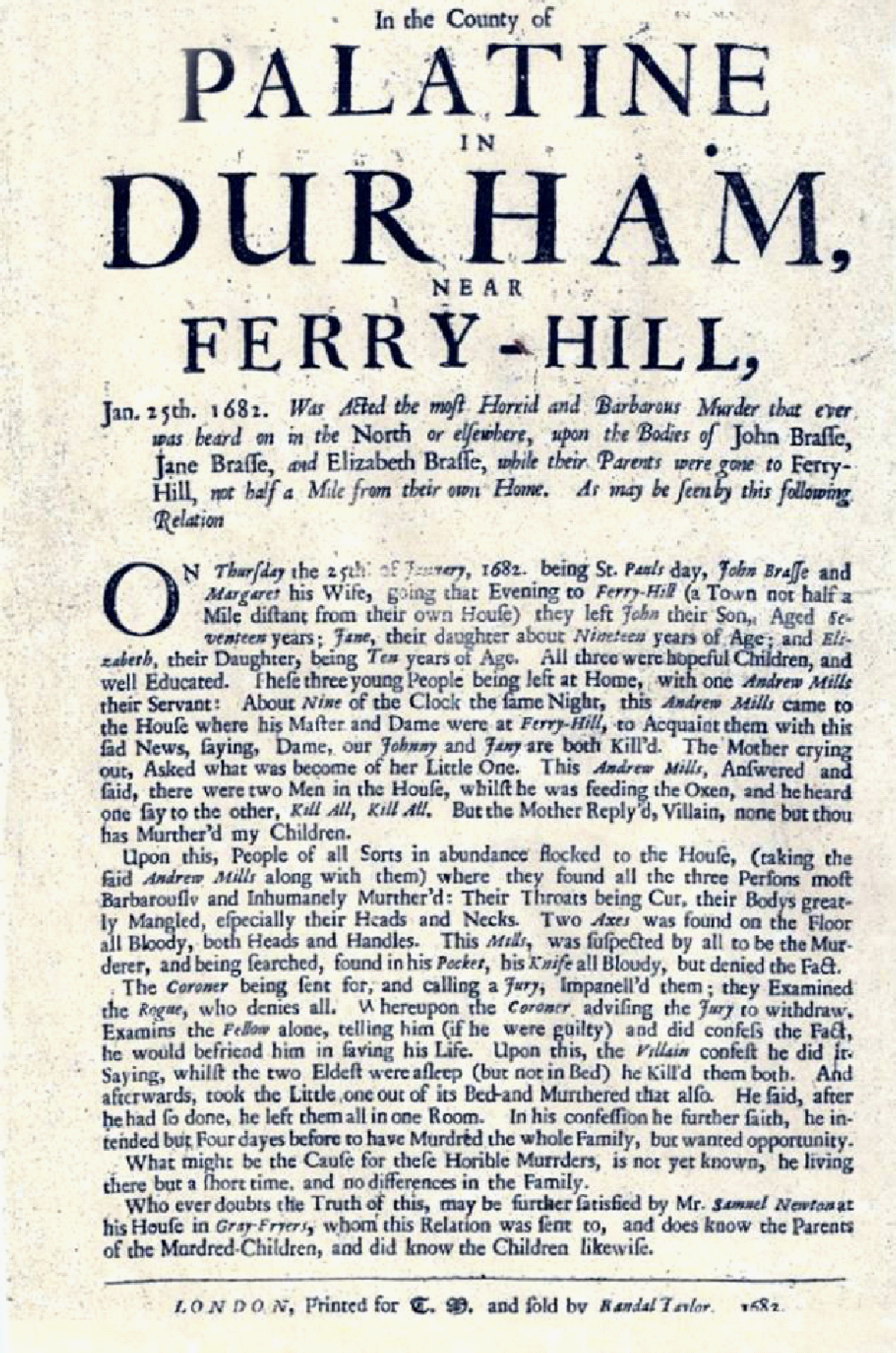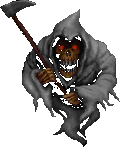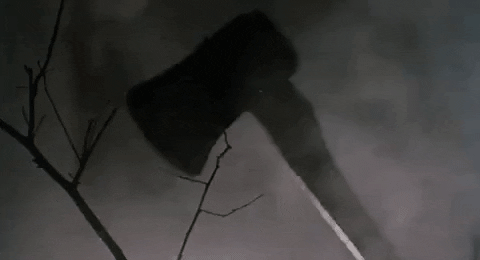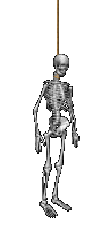The Mills Murder
John, Jane and Elizabeth Brass were the children of John and Margaret Brass who owned Brass Farm, west of Ferryhill – now known as High Hill House Farm. The oldest child was Jane Brass, who was about at the time of the murder 19 years old. John, the second oldest and the only son in the family, was 17 years old The youngest was Elizabeth, who would have been about 10 years of age.One 19th century author described Jane, who, with her raven (black) hair and ruby lips, she was “rendered brighter by perfect health and made temptingly beautiful by an arch ness of manners which tantalised the young farmers who spent evenings at Hill House”. Jane was indeed a beacon to all the young swains of the neighbourhood. John was described as a “Cheeky and somewhat idle… who enjoyed ridiculing his father’s workers. Part encouraged by his parents, he particularly enjoyed teasing Mills”. The ‘little lass’ Elizabeth “Enjoyed playing in the surrounding fields after finishing her daily chores”. Elizabeth showed affection towards Mills, and the pair “would often be seen playing with her dolls and toys or chasing ducks around the yard”. In the 17th to 18th Centuries, the Brass family of Ferryhill were wealthy. They could afford their own farm, they were able to have their children to be well educated, and thirdly, the parents were able to afford alter-tombs for their children’s funerals and their own.. Robert Suttees of Mainsforth, who researched and wrote the volumes “The History and Antiquities of the County Palatine in Durham” in the 19th Century, mentions Andrew Mills confession. Accordingly, he chased the two elder children into a bedroom, where Jane managed to bolt the door locked just before Mills reached her. He then thrust his axe against the wood. It did not take much before the iron hinges started to move, and the wood stables to shatter. In desperation, Jane used her right hand and put it through a crack, and used it as a makeshift bolt. It only took the final blow, and Jane’s arm he bolted from the house, and ran into Ferryhill where his blood-stained clothing and wild talk sealed his fate. Andrew Mills rushed into the home of which John and Margaret were visiting, and proclaimed to his employer that two men had broken into the farmhouse and had murdered all the children, during the time when Mills had been apparently “feeding the oxen”, and had overheard one man say to the other “Kill them, kill them all”, however, Margaret Brass, the employer’s wife, possibly noticing something about Andrew Mills clothing, and body language, cried out, “Villain, none but thou has Murther’d my Children” Upon hearing Andrew’s account, lots of people within Ferryhill flocked to Brass Farm, taking Andrew Mills with them, where they found all the Children barbarously murdered in a bedroom. Two (short handled?) blood-stained axes were found at the scene of the crime. Everyone at this point suspected that Andrew Mills was the murderer and upon being body searched, a blood-stained knife was found in his pocket. However Mills protested his innocence. A coroner was sent for, and a panel of people were empanelled as jury and questioned Andrew about the murders, but, with Mills still insisting on his innocence, the coroner asked the jury to withdraw, and he then asked Mills that if he was guilty of the murder and confess this fact, then he would befriend Mills by saving his life. He confessed and was subsequently arrested and taken to Durham Goal.According to some books, troops marching from Darlington to Durham that very night apprehended Mills as he came running into Ferryhill with wild news of a triple murder. It is possible to suggest that the troopers, upon seeing Andrew Mills’ blood-stained clothing, seized him and by chaining up his hands, took him to the house where John Brass and his wife were present. Upon seeing Mills in the company of His Majesty’s troops, Margaret Brass suspected at once that Andrew, her husband’s servant, had committed the murders It also follows that when Mills was taken back to the murder house, the troopers had with him for a while but it wasn’t long before he too lost some sort of concentration with the fight, and Mills knocked him in the head with the axe. John lay in pain on the floor, dying from a fractured skull. He then proceeded with cutting his throat. He then went to Jane and killed her. According to the folio sheet of 1682, it states that the children were “most Barbarously and Inhumanely Murdered: Their Throats being Cut, their Bodies greatly Mangled, especially their Heads and Necks.” A theory for such a brutal attack is that Mills, in an insane state, did not see the human features on the faces of his victims, but hallucinated those of demons. He smashed in their faces and heads as the “demonic” faces of the children plagued, tormented, and laughed at him. Of course, with such an attack, the children were screaming in pain, and so, Andrew Mills using his pocket knife, slashed open the children’s throats to stop the noise.Elizabeth was screaming and Mills then turned, and put his attention, with his wide wild violent eyes, to her, who now, so terrified, lay shaking violently and hiding under her bed linen. According to Mills’s confession, he had a fond relationship with the eleven year old, whilst being in employment. It was due to his childlike ways. Elizabeth cried in sorrow, and prayed to Mills to spare her life. She offered him bread, butter, sugar, and toys – all the little things that meant so much – in return to keep her soul. Andrew left the room and it seemed that Elizabeth was going to be spared. When Mills left the room whilst Elizabeth’s life was at the edge of her hands, he walked in to the dark corridor near the stairs where he chased Jane, and it was here, according to his confession, where the Devil in the shape of a hideous creature met him in the passage. The Devil told him to spare no-one, and with the words, kill, kill, kill, ringing continuously in his ears, Mills returned to the room, dragged the girl from under her bed and began by “dashing out her brains” Legend stated that Mills stayed with his bloody victims for quite some time but realizing the enormity of his crime,him for safety purposes. It is suggestible that one of the troopers was dispatched to bring a coroner to be present. At some point Andrew Mills confessed to the murders, and this sealed his fate. He was taken immediately to Durham City to await his trial. I won’t go into the trial itself, suffice to say that the hearing is a matter of public record and extracts can be obtained from the excellent coverage at http://www.ferryhilllocalhistory.com/Ferryhill/AndrewMillsIndex.htm from which most of this story is copied. (Acknowledgement). Andrew Mills was sentenced to be hanged at Durham. As public opinion was high in that time, it was demanded that his body should be brought back to near the scene of the crime to be displayed. So before he was hung, he was measured by a local blacksmith – usually hired by the Court – in his condemned cell. He was measured for his last suit – a gibbet cage for which his body would be later displayed. He was executed almost immediately after being convicted and sentenced. Soldiers escorted Mills from the Court, and put him into a metal cage on a cart where he was then driven through the old streets of Durham. Crowds would almost certainly have hurled abuse and thrown rocks and rotten food at him as the cart and escort wound its way through the old streets of Durham towards the hangman’s noose. The exact location of the execution is not certain, but there are three possible locations mentioned by local historians. The first being Gallows Field, now the site of St. Leonard’s Roman Catholic School, the second being Gilbert Knowles, formally called Gibbet Knowles. This is now a street called ‘Black Western Hill’. The third location is now the site of the University Hospital of North Durham. It is possible that all three locations were used as execution spots at one time or another.At the site of Andrew Mills’ execution, there was a public gallows set on a high platform with a strong wooden beam running across the top, attached to it some hanging ropes. His hanging would have drawn a massive crowd. The rope was placed around his neck and at the last beat of a soldier’s drum, a hole beneath his feet opened, and he was hung until he was dead. A doctor announced his death at the scene. A few days later, he was taken down from the rope, and before his body was placed in his metal cage, it would have tarred with pitch for preservation.. Andrew, inside his cage, would have been lifted onto a cart and driven by soldiers to the location, a three-quarter mile north of Ferryhill, overlooking the scene of the murder. He was placed in his gibbet on Wednesday 15th August 1683.It was said that his gibbet overlooked the scene of the murder, at a half mile distance north of Ferryhill. Even today, at this distance, you can still see High Hill House Farm on the ridge facing west. His gibbet would have been a 30 foot, strong, wooden post where an iron compartment, holding inside the body of the criminal, hung from. His body was left to rot – his flesh and eyes pecked and eaten by crows – until all his bones fell out of his metal cage.So how did the word “executed” come to be removed from the alter stone? During the 18th Century, a man called Willy Lynn, who owned the ‘Bay Horse’ public house at Merrington, was often fond of an argument with his customers. He believed that Andrew Mills could not have died by execution but death by being hung alive, and by trying to make some point, he entered the Church yard, and scratched off the word ‘Executed’ from the murdered children’s alter-tomb.”So there it is, the story of the Brass family murders, all clearly explained. I hope that you found it as fascinating to read as I did. There’s a few more stories waiting to be discovered in Merrington churchyard, such as the former Naval Surgeon whose last will and testament is inscribed on his gravestone. It makes interesting reading and simply has to be followed up. I guess there’s another article in it for the future






